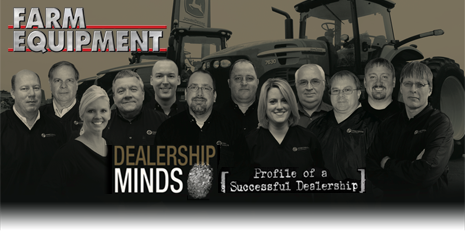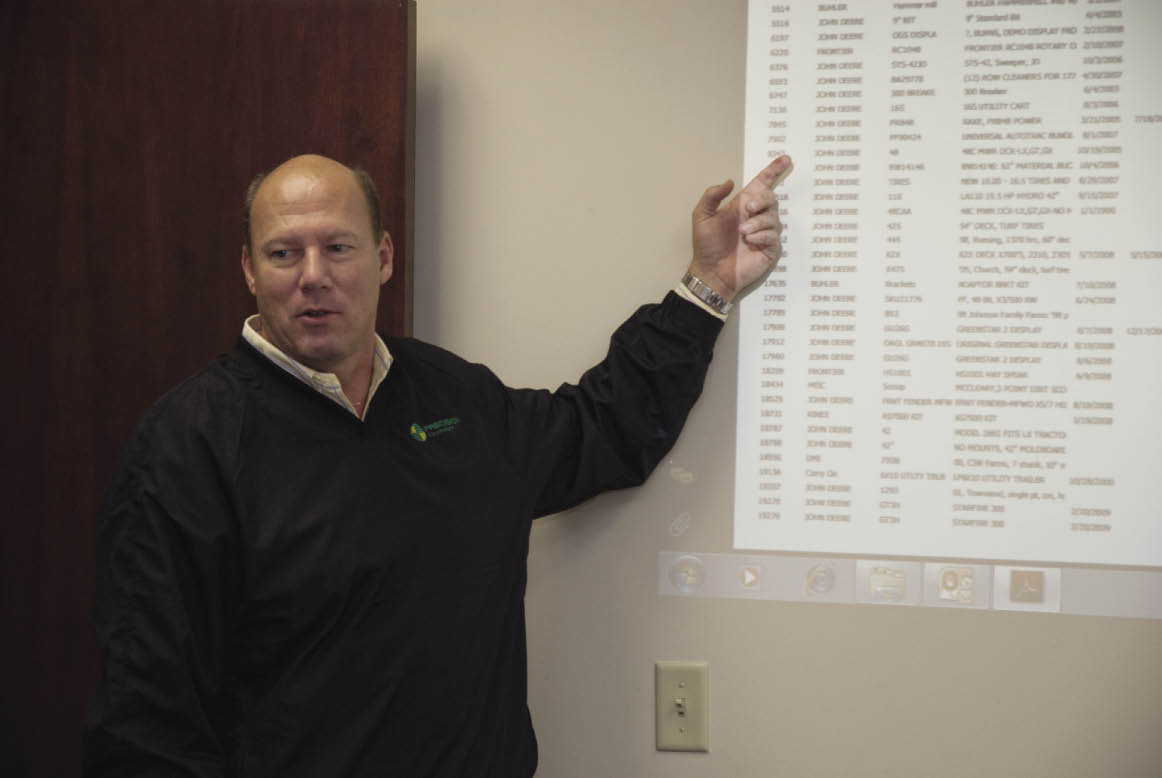

CFO, VP of Finance & Admin: Dave Dahms
Years with Organization: 4.5, previously employed for 22 years in finance and treasury operations in the commercial tire business.
Role: "The CFO is kind of like a chef in the kitchen. You've got to be able to understand all the ingredients and how they work to make up whatever you're cooking. It's about putting all those ingredients in at the right time and testing it and making sure it's correct. Getting that mix right throughout the year is my responsibility." Dahms also oversees all accounting (including risk management and tax) and HR.
In some (maybe even most), companies, non-financial folks can look at accounting departments with a jaded view. “They count the beans,” some might say, “while we do the real work around here selling and servicing farm equipment.”
No evidence of such antiquated thinking was seen in our time at Precision Equipment. In fact, Dave Dahms, CFO and vice president finance & administration makes it clear that his first order of duty is to support the employees.
“My first role is to free employees from roadblocks standing in the way of fully accomplishing their jobs,” he says. “We can’t accomplish our goals without allowing the folks to accomplish their tasks and responsibilities.”
His second role, he says, is to provide the leadership team with all the information, analysis and forecasting needed to understand the operations and make good decisions. The thoroughness of planning may be what’s most impressive about Dahms and his 11-person crew, and could be the primary reason the firm has been able to make the transition with owners who once ruled day-to-day, but have since stepped aside in a silent role.
The emphasis on planning — a discipline Dahms learned outside the industry — brings a controlled approach to the business. It’s not about going where the market takes you.
Financial Philosophy
Dahms did not “grow up” in a equipment sales nor distribution business. Rather, he and CEO Randy Amosson are from the manufacturing side of Bandag. This perspective proved valuable in understanding the motives behind manufacturers’ programs and the needs of dealers.
Like most successful dealers, Dahms is a champion of cash flow management. “It’s not just the lines of credit you establish through your banks or your suppliers; it’s also the amount of inventory turns that you have, the manner in which you regulate your gross margins and control expenses. All of that flows back into the cash flow statement. From a financial perspective, you’ve got to understand all of those connectivities and how to manage those to be able to really get back to how much credit and operating balances are needed to sustain the business.”
Dahms says dealers must be diligent against leveraging themselves. “It’s very easy to get overextended today because we’re looking at commodity prices and all the buying going on. We’re in a very good environment — probably one of the best years that dealer businesses have seen. But the crystal ball isn’t quite as clear.”
That’s where a discipline of “touching the brakes” is put to good use. “I ask a lot of ‘Are you sure?’ questions and also the things that could happen that maybe we haven’t thought about.”
Measuring What You Want to Move
When asked about the metrics that he emphasizes with the organization, Dahms cites Deere’s “Dealer of Tomorrow” requirements, including market share, customer experience, total wholegoods sales, return on assets, return on sales, absorption and customer experience. He then split the discussion to communicating with both the leadership team and the location managers.
SIDEBAR:
Advice for the Merger Marriage
With the leadership team, the overall efficiency of the business is what is stressed most. Citing inventory as an example, he explains how there is an inventory timeline for every product group. “Those timelines dictate pricing, where to direct sales efforts and inventory levels.
“So if we want a 3.5 turns on a unit, then based on our budget, we’ll know how many to stock. Those are the things we look at vs. saying our gross margin should be X, or our expense-to-sale should be 8.5%. We use tools like timelines to affect, and manage, the business.”
For the individual location managers, the dealership recognized the practical limitations of the P&L statement alone. “There’s more to understand than just giving a P&L to a location manager,” he says. About a year ago, the company saw a program shared by Deere’s Dealer Development group and modified it to work for the dealership.
Dahms describes the scorecard as a hybrid of a P&L statement and a “what if” calculator. It’s an Excel spreadsheet that extracts information from the dealership’s EQUIP business system.
“Each month, location managers get a spreadsheet that shows overall store performance by department coupled with a calculator that presents various ‘what if’ scenarios. If we want an extra half-
percent in gross margin, we show what needs to be tweaked to get there. Small tweaks can bring a significant amount of margin change.”
SIDEBAR:
Good Days, Bad Days
In place since last spring, the scorecard has been helpful in getting all managers to better understand the business and its success factors, says Dahms. “If managers are not on board or don’t understand what we’re asking of them, we’ll never accomplish our end game.”
Budgeting: Times 3
If you’d rather see a dentist than undergo the double and triple checking of annual budget figures, consider this about Precision Equipment: They do not one, not two, but three annual budgets each year. Dahms explains:
Peak Budget — “This is where everything goes perfectly, the year is absolutely the best it could be.”
Normal Budget — “This is a scenario in which there may be equipment availability problems, weaker market demand or operational surprises but things are still going reasonably well.”
Trough Budget — “This is if things really go bad; if all of a sudden something happens in the economy or there’s a very weak market. This exercise prepares us for significant adjustments in operational expenses. You hope to never put it in place, but we know we better have it in our back pocket in case that happens.”
Exclusively Online
CFO Role More
Critical in Today's Dealership
The revenue forecast starts by product category. “We’ll arrive at a number of combines, both new and used, that we expect to sell. That gets driven down by store and then by salesman. So when we go to the location manager we can say, ‘Here’s your revenue line, here’s the number of units, and here’s the number of units by salesman expected from your location.’”
Using historical data and projected price increases, a gross margin level is developed. “From there, we go through all the expense lines, zero-based budgeting on some, and then determine if the bottom line is adequate. If not, we go back and readjust both revenue and expense.”
The dealership operates on a calendar year, and will have its budget ready by November for the coming year.
By May, the dealership will reforecast the second half of the year. “It’s a good iteration to help plan what the following year will look like,” he says.
Dahms says one of the biggest risks is only looking at the next 6-12 months. “Past that, things become very cloudy real quick. So the business must prepare for 24-36 months out, and we need to keep our eye on that because things are going to change. If we don’t start working on it now, we’ll never be prepared when it happens.”
A Singular Goal for 2012
The biggest challenge as CFO, according to Dahms, is the post-integration activities, which entails rewriting major processes to find additional efficiencies. The list includes everything you can imagine, from employee benefit designs to wholegoods processing to buying shortline products to marketing.
“It’s an undertaking and we, as a process-driven business, don’t take that project lightly. With eight locations, it’s critical that everything is done the way the process is written. It’s a lot of work, but critical for the entire organization because we know we’ll find things that we can improve.”
When asked about his goals for 2012, there was no hesitation. “Getting both companies fully integrated into Precision Equipment.” That will be accomplished, he says, when everything on the post-integration list has been checked off and processes are in place so every location is operating consistently day to day, and employees all feel part of one powerful entity.”
“We’re disciplined about determining the things that we need to work on, laying out a plan for how to do it and getting the right people and processes in place. And establishing internal controls to make sure those processes are operating correctively and effectively.”






